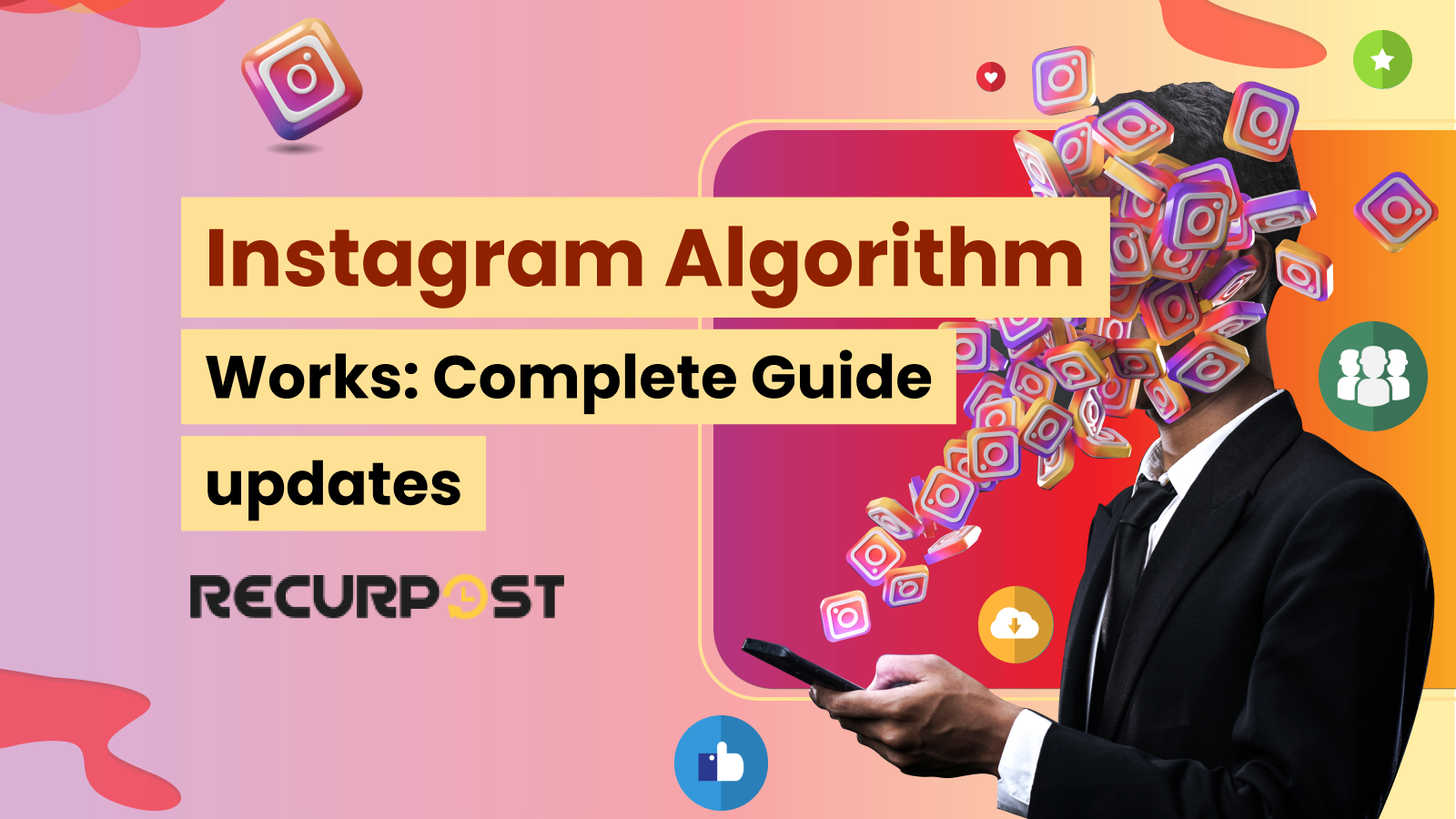The Instagram algorithm is a system that decides what content appears in your Insta feed. Knowing how the Instagram algorithm works in 2025 helps you reach more people and grow your following.
In this blog, you’ll see how the Instagram Explore Page, Reels, Story, and Feed algorithms function under the Instagram algorithm 2025 updates, along with tips for content that can boost reach.
Instagram does not rely on a single algorithm to run the platform. Each part of the Instagram app, including Feed, Stories, Explore, Reels, and Search, uses its own Instagram algorithm shaped by how people interact with that feature.
This blog explains Instagram algorithms in 2025 and how you can work with them to gain more visibility and build your audience.
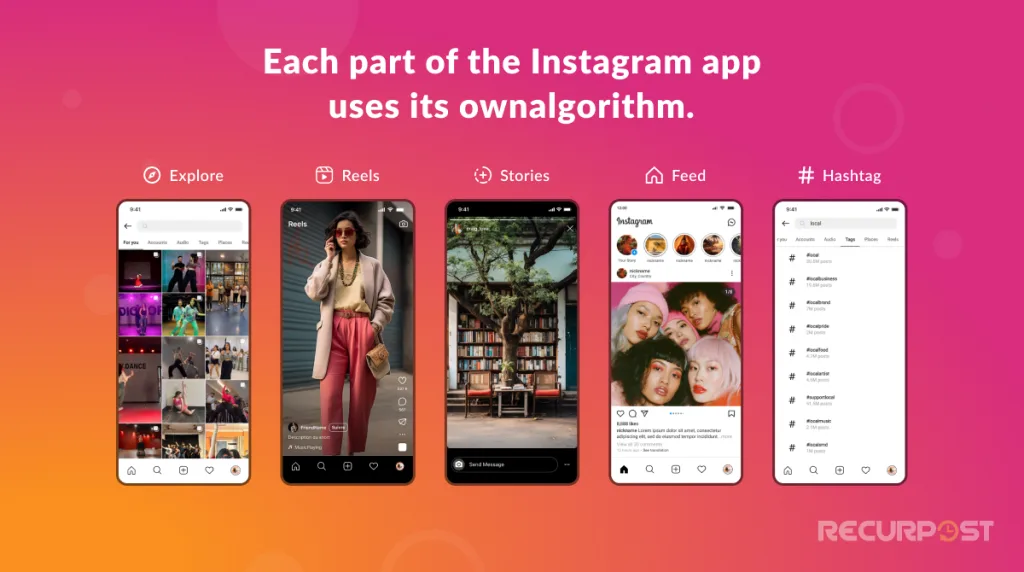
How Does The Instagram Explore Page Algorithm Work?
The Instagram Explore page algorithm studies several factors to recommend content that boosts Instagram views and matches user interests:
- User Interaction: The Instagram reviews posts a person likes, comments on, and shares. It detects patterns in what each user responds to.
- Content Engagement: Posts with strong engagement, including likes, comments, shares, and saves from many users, are given priority by Instagram.
- User Activity: The algorithm also tracks searches, profile visits, and browsing patterns to personalize the Explore page with content tied to user interests.
- Content Similarity: If someone interacts often with posts on a topic, the Instagram algorithm places more related posts in their Explore feed.
- Creator Activity: Instagram factors in the reach of creators that a user follows. Posts with strong engagement are more likely to surface in Explore feeds.
- Timeliness: Instagram gives preference to recent and trending content, so Explore feeds highlight the latest posts.
How the Instagram Reels Algorithm Works?
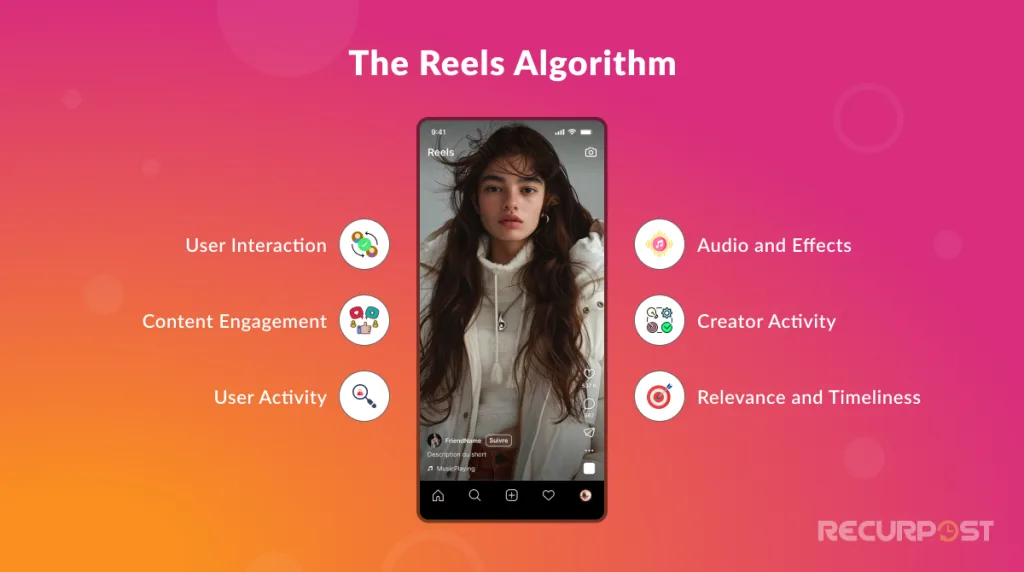
The Instagram algorithm for Reels ranks videos based on factors that shape user engagement and keep the feed enjoyable:
- User Interaction: The algorithm tracks the reels users like, comment on, and share. It recommends more reels that match those preferences.
- Content Engagement: Reels that gather strong engagement, including likes, comments, and shares, are boosted by Instagram and shown to more users.
- User Activity: Instagram studies searches and viewing patterns to suggest reels linked to each user’s activity.
- Audio and Effects: Reels using trending audio tracks or effects are pushed higher since Instagram favors popular creative tools.
- Creator Activity: When a user often engages with a creator, the algorithm surfaces more of that creator’s reels in their feed.
- Relevance and Timeliness: The algorithm gives preference to fresh and trending reels, so feeds stay current and engaging.
How does the Instagram Story algorithm work?
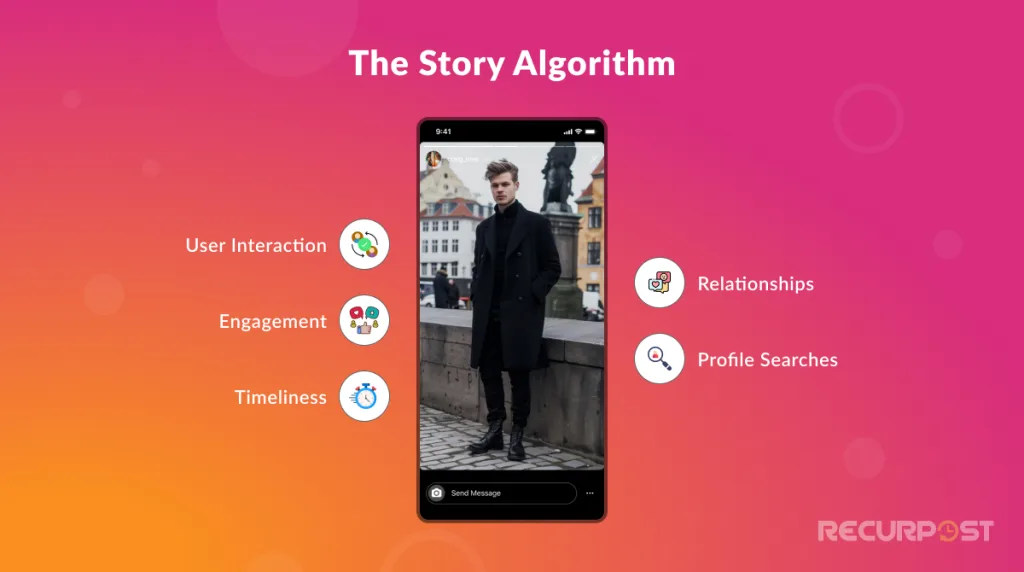
The Instagram algorithm for Stories considers these factors to decide which stories appear at the top:
- User Interaction: The Instagram algorithm gives priority to stories from accounts a user interacts with most through likes, comments, or DMs.
- Engagement: Stories that spark strong engagement, such as replies and shares, are ranked higher by Instagram.
- Timeliness: The algorithm pushes newer stories first so users see fresh updates before older ones.
- Relationships: Stories from close friends and family appear earlier in the feed since Instagram weighs past interaction history.
- Profile Searches: Instagram also tracks frequent profile searches, giving those stories a better chance of appearing first.
How Does the Instagram Feed Algorithm Work?
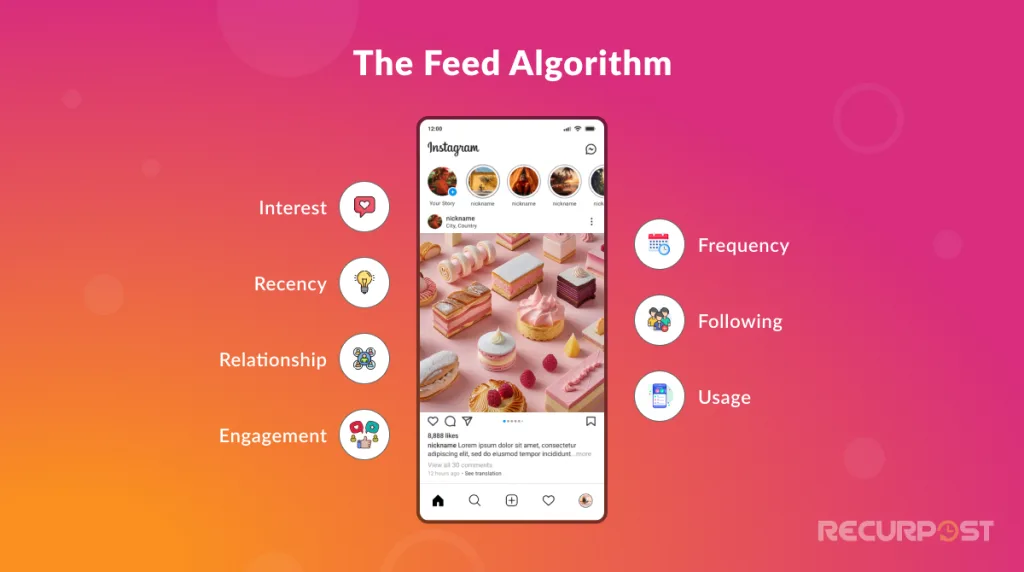
The Instagram feed algorithm ranks posts using these main factors:
- Interest: The Instagram algorithm predicts user interest by studying past actions, patterns, and interactions to decide which posts may appeal.
- Recency: The Instagram algorithm gives preference to newer posts, placing them higher than older ones to keep the feed current.
- Relationship: The Instagram algorithm ranks posts from friends, family, and accounts with frequent interactions higher in the feed.
- Engagement: Posts with strong engagement, such as likes, comments, shares, and saves, are lifted higher in the feed by the Instagram algorithm.
- Frequency: The Instagram algorithm considers how often a user opens the app, showing the most fitting posts since their last session.
- Following: The number of accounts a person follows influences the Instagram algorithm. With more followers, the feed mixes content from a wider range.
- Usage: Longer time on Instagram expands the feed, as the Instagram algorithm includes a broader variety of content for active users.
How the Instagram Hashtag Algorithm Works?
The Instagram hashtag algorithm ranks posts with hashtags that gain strong engagement and match content, helping boost discoverability. Using hashtags the right way can expand reach and visibility for creators, brands, and agencies.
Insights from Adam Mosseri on Instagram’s Algorithm
In a series of recent videos, Adam Mosseri, head of Instagram, shared how the algorithm ranks content across the app. He noted that Instagram uses different algorithms for Feed, Stories, Explore, and Reels. Each algorithm applies signals to decide what content users see.
For example, in the Feed, the Instagram algorithm weighs engagement history, post popularity, poster details, and user relationships. In Reels, it emphasizes entertainment, factoring in watch time and interactions.
Mosseri cleared up misconceptions, stressing that there is no single Instagram algorithm. Instead, the app uses a mix of algorithms, classifiers, and systems, each serving a clear role. He underlined that original, engaging content performs best, since the algorithm pushes posts that connect with users and spark interaction.
For more details, you can watch Adam Mosseri’s full explanation here:
Instagram Algorithm Updates in 2025
The Instagram algorithm introduced several updates in 2025 aimed at shaping user experience and strengthening content discovery:
1. AI-powered content recognition: The 2025 update improved Instagram’s capability to categorize content beyond hashtags, analyzing visuals, text in images, and video clips to match posts with users.
2. Relationship-based ranking: In March 2025, Instagram gave stronger weight to accounts that users interact with often through DMs, comments, and story replies.
3. Content authenticity: The algorithm now favors original posts over recycled material, rewarding creators who publish fresh content instead of reposting.
4. Engagement quality: Instead of just tallying likes or comments, the 2025 Instagram measures the depth of engagement. Meaningful comments and saves carry more weight than quick reactions.
5. Cross-platform signals: Instagram now considers engagement across Meta platforms. Posts that do well on Facebook may also gain visibility on Instagram.
6. Viewing time: Instagram tracks how long users watch content, pushing formats that lead to longer viewing sessions.
7. Lower hashtag weight: Hashtags still matter, but the algorithm relies more on content analysis and user behavior patterns than hashtag use.
These Instagram updates in 2025 show a move toward tailored content feeds while balancing reach for creators and experience for users.
How to Beat the Instagram Algorithm?
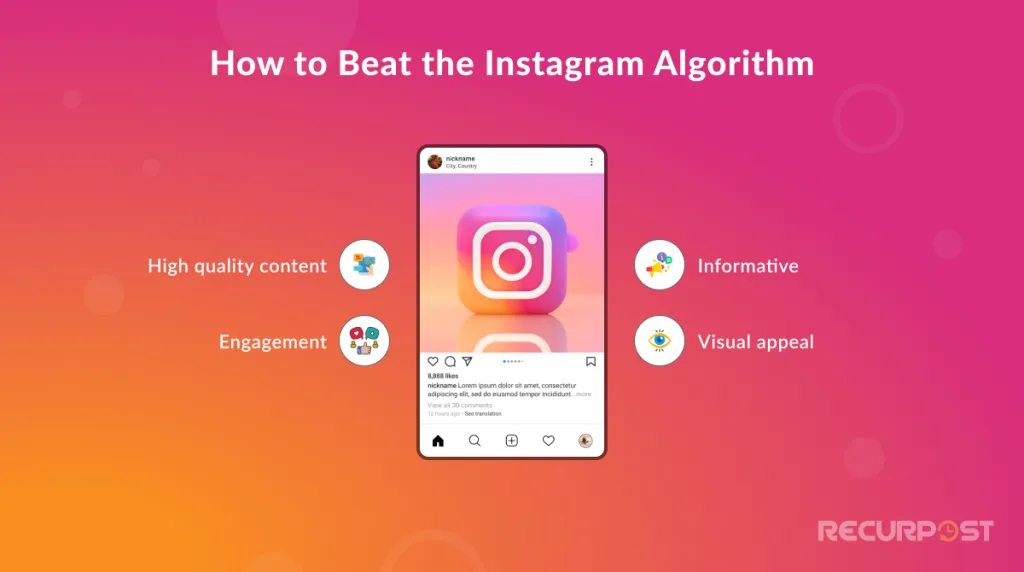
- Share high-quality posts that match your audience’s interests and look visually strong. [Check 35 Best Instagram Post Ideas].
- Use polls, stickers, contests, or questions to drive interaction. Instagram rewards higher engagement by ranking your content higher.
- Post on a steady schedule. The algorithm prefers accounts that stay active. Aim for once a day, but not more than a few times daily. Use Instagram scheduling tools to plan ahead.
- Add trending hashtags that fit your post. The algorithm uses hashtags to expand reach, showing your content in hashtag search results.
- Engage with others by liking, sharing, and commenting. Instagram values real interaction and shows that you are active in the community.
- Mix formats: photos, Reels, Stories, and videos. Instagram favors variety, so switching formats keeps your audience engaged.
- Post strong visuals. Since Instagram is visual-first, the algorithm favors clear, high-quality images and videos that match the post.
- Write Instagram captions that are clear, short, and engaging. Use them to ask questions, start conversations, or direct followers to more content.
- Add stickers and geotags for reach. The algorithm tracks these signals to show your content to more people.
- Promote your Instagram on other platforms. Share your posts across networks and add your Instagram profile link to bios.
- Stay current with Instagram algorithm changes, including possible Instagram algorithm resets. Follow @Instagram and @Creators for updates, and adjust quickly to maintain reach.
Learn About Other Social Media Algorithms
- YouTube algorithm: See how YouTube recommends videos and builds its watch feed.
- Facebook algorithm: Learn how Facebook ranks posts and decides the order of news feed content.
- Twitter algorithm: Find out what signals make tweets more visible in timelines.
- LinkedIn algorithm: See how LinkedIn ranks posts and articles for professional feeds.
- Pinterest algorithm: Learn how Pinterest picks and displays content for user boards and feeds.
Benefits of understanding the Instagram algorithm
Knowing how the Instagram algorithm works matters for several reasons:
- Creating posts that your audience sees more often. The algorithm matches users with content they like, so knowledge helps your posts rank higher.
- Growing on Instagram by reaching new people who like your content type. Using strong hashtags helps your posts appear in hashtag searches.
- Increasing engagement rates. The algorithm favors posts that spark likes, comments, and shares, so understanding it helps you design engaging content.
- Staying updated with platform changes. Instagram updates often, so being aware helps your content keep reaching the right audience.
Knowing the algorithm brings direct benefits for different groups:
- Business owners: The algorithm can help reach people who are likely interested in your products or services.
- Content creators: The algorithm can expand your reach and help grow your following.
- Influencers: The algorithm supports brand growth and makes it easier to connect with companies that match your audience.
Whatever your goal on Instagram, knowing how the algorithm works is a major factor in long-term success.
Conclusion
The Instagram algorithm works by weighing many factors when ranking content. Knowing how the platform’s algorithm functions helps your audience see your posts more often.
Consistent content, steady interaction, and timed posting all shape how Instagram treats your account.
Scheduling Instagram posts when your audience is active improves reach and visibility. Adapting to the platform’s algorithm updates helps keep performance steady.
Post scheduling represents one factor affecting Instagram’s algorithm. For more insights across platforms, see our Social Media Algorithms Explained guide.
FAQs on Instagram Algorithm
1. Does editing an Instagram post affect the algorithm?
Editing posts can hurt early engagement. Instagram tracks the original post time, not edit time. Removing or changing hashtags may lower visibility in hashtag feeds.
For Reels, edits after posting can reset engagement signals, cutting reach. The 2025 Instagram algorithm update confirmed that the first 24–48 hours of engagement matter most.
2. How do I increase my Instagram algorithm?
Share quality posts for your audience, post regularly, and encourage interaction. The Instagram algorithm rewards steady engagement.
3. Why is my Instagram doing so badly?
Low results can come from posting irregularly, weak content, or a lack of engagement with followers. Instagram favors steady activity.
4. What is the best time to post on Instagram?
The best posting times vary by audience. The Instagram algorithm usually favors daytime posts when your followers are most active.
5. How does Instagram’s view work on the story?
Each view counts when someone watches your story. The algorithm pushes stories to users who interact with your posts often.
6. How to understand the Instagram algorithm?
Pay attention to engagement, timeliness, and post quality. The Instagram algorithm uses these signals to rank content.
7. How does Instagram rank story viewers?
Story viewers are ranked based on interaction. The algorithm prioritizes those who engage with your posts most often.

Dr. Dinesh Agarwal, founder of RecurPost, holds a PhD in Cloud Computing and transitioned from academia to social media innovation in 2013. He built RecurPost into an enterprise-grade automation platform now used by over 100,000 businesses worldwide. Beyond leading RecurPost, Dr. Agarwal shares insights on social media marketing through talks, podcasts, and articles, with a focus on content optimization and algorithm-driven distribution.

